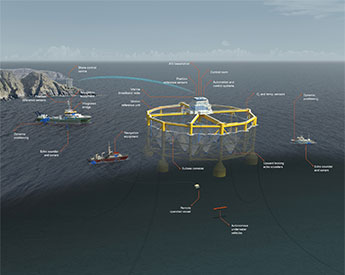|

Automated facility for offshore aquaculture operations. (Image: Kongsberg Maritime)
Innovative ocean aquaculture project authorised
 (NORWAY, 4/5/2016)
(NORWAY, 4/5/2016)
The Norwegian Ministry of Trade and Fisheries has approved the country’s first development concession to overcome the challenges of more traditional inshore fish farming facilities by being located in deeper waters, further from the coast.
Ocean Farming AS, supported by Kongsberg Maritime AS, has been authorised to build the world’s first automated ‘exposed’ aquaculture facility, situated outside of Trondheim.
This innovative new facility introduces a paradigm shift in salmon farming now, and other fish types in the future and is a significant step in Norway’s efforts to deliver technical solutions to address the impending global food gap challenge.
The submerged, anchored fixed structure will float steady in the exposed ocean and is suitable for water depths of 100 to 300 meters, where the aqua biological conditions are more ideal for aquaculture on ‘the fish’s terms’.
The benefits of offshore fish farms are numerous, with conditions more suited to nurturing healthy fish, such as steady currents that limit exposure to sea lice infection. The facility is fully automated with normal operation requiring a crew of just 3 – 4 people. It can also be remotely operated.
The project combines the best of existing technology and solutions from the Norwegian fish farming industry and the offshore oil and gas sector.
Kongsberg is playing a key role by leveraging its position as a turnkey supplier of technology and engineering services for complex oil & gas production units, offshore vessels, fisheries and sensor systems for oceans research and environmental monitoring.
Below the water, sophisticated products from KONGSBERG will provide a clear view of the action. Leading the subsea delivery is the high-tech Simrad EK80 scientific echo sounder, a range of underwater cameras and an Acoustic Doppler Current Profiler (ADCP), velocimeter and O2 sensors. Other sensors include Tank Sounding and Water Ingress Detection.
The subsea delivery is designed to accurately detect where the fish are in the vast water volume of the cage and how they move in order to ensure effective feeding. In addition, advanced 3D display of the fish and relevant environmental parameters will be provided to the operators.
The project will be the first in the world to combine marine engineering, marine cybernetics and marine biology via a ‘big data’ approach fusing all the available underwater sensors and in this way offer decision support systems for the operators controlling and monitoring the feeding of the salmon and the overall physical environment of the sea.
“With greater focus on biology and nurturing healthier fish, the concept delivers significantly improved yields that will prove important in the decades to come as part of Norway’s strategy to leverage its aquaculture and offshore expertise to meet the challenges of accelerating population growth and the pressures this places on the world’s food supply chain,” commented Egil Haugsdal, President, Kongsberg Maritime.
For his part, Thor Hukkelås, Principal Engineer Aquaculture Operations, Business Development, Kongsberg Maritime pointed out: “To succeed in placing fish farming in exposed areas as a viable solution to address the food gap challenge, we need to integrate and harmonise a wide range of maritime and offshore technologies, for the fish farm itself and the new vessels that will serve it.”
[email protected]
www.seafood.media
Information of the company:
|
Address:
|
Kirkegaardsveien 45, P.O. Box 483,
|
|
City:
|
Kongsberg
|
|
State/ZIP:
|
(NO-3601)
|
|
Country:
|
Norway
|
|
Phone:
|
+47 32 28 50 00
|
|
Fax:
|
+47 32 28 50 10
|
|
E-Mail:
|
[email protected]
|
More about: 
|
|
|
|



